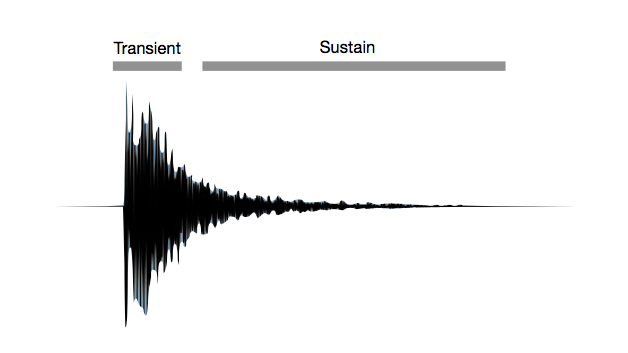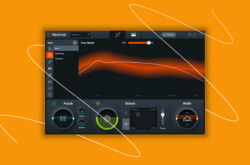Illustration: Corri Spencer
Adding punch to your drums is a great way to add excitement, energy, and that special oomph to your track. In this article, we will look at three tips for getting more attack and body out of your drums.
1. Transient shaping tools
Drums are transient instruments. When you look at the waveform of a single drum hit, it usually has a lot of energy at the beginning of the waveform, and it quickly tapers off. This initial burst of energy is called the “transient” of the waveform.

Transient shapers like the one in iZotope’s Neutron 3 are a great way to control the attack and sustain of your drums independently. These special dynamics processors can add incredible detail to your drums, or they can make them bigger depending on how you use them.
Generally speaking, these tools usually have two knobs. One is for the “Attack”, the other is for the “Decay” (also called “Sustain”). Turning up the attack will make the initial part of the sound louder. The initial part of the drum sound (the “transient” itself), is the most important part of the waveform when it comes to the “punchiness” of the drums.
You can also play with the sustain in order to add body to the drums. I generally like to boost the attack by 2-3 dB, and the sustain by 1 – 1.5 dB.
2. EQ settings for kick, snare, toms, and cymbals
Proper use of EQ can also improve the overall energy of your drums, while helping them to sit in the mix. Here are the EQ curves I like to use on specific drums:
Kick
On kick drum, I like to roll off everything below around 40 Hz. This super low energy in the kick is usually not heard, and can detract from the frequencies that matter when you start compressing the kick. I also like to cut between 200 Hz – 300 Hz by 3-4 dB. This helps to clean up the muddy sound while keeping the thump and detail of the kick.
Snare
I generally like to roll off the low end of the snare as well, for the same reason as the kick. Next, I like to boost around 400 Hz in order to add body to the snare (only if needed). Otherwise, the snare drum is usually the least EQ’d of the drums in my sessions.
Toms
For these, it really depends on the sample. If I want them to sound big and beefy, I’ll treat them similar to the kick. I’ll roll off the super low end, cut the muddy frequencies around 300 Hz, and potentially boost 100 Hz to add some low end. If I want them to sound thin and “in your face”, I’ll roll off a lot of the low end, sometimes up to 200 Hz. Then, I like to boost somewhere between 1 kHz by 2-3 dB if needed.
Cymbals
On cymbals (hi-hat, crash, white noise, etc.), rolling off the high end using a shelf set to around 5 kHz is an important step for most tracks. This takes away the edge of the cymbals so that the track isn’t too bright. I like to also roll off the low end, sometimes up to 2 kHz, in order to make it sound cleaner (if needed).
The important thing to remember when EQing your drums is to take out the muddy frequencies in the lower drums, and to tame the high frequencies in the cymbals. This will allow you to turn them up in the mix while still keeping a nice clean sound. By turning them up, they’ll sound bigger and punchier
3. Compression techniques for more body
Compression, when used carefully, can be a great tool to add body to your drums. It is important that you not over compress your drums, or you will lose all of the transient work that you did.
I like to use multiple compressors on the drum bus (an aux track with all of the drums feeding into it). This allows you to compress them as a whole rather than individually, making it sound more cohesive and “glueing” them together.
I keep the ratio very small on these compressors, usually 1.5:1. The threshold is set to the point where I see about 1 – 2 dB of gain reduction. By stacking 2 or 3 compressors with these settings, they start to glue together the drums and create a thicker sound.
As always, with any mixing techniques, it is important that you listen to your tracks and make decisions based on what you hear. These suggestions for punchier drums are simply tools to start with and try out on your own tracks.
What techniques do you like to use when you’re sculpting your drum sound?
Explore royalty-free one-shots, loops, FX, MIDI, and presets from leading artists, producers, and sound designers:
November 20, 2017



